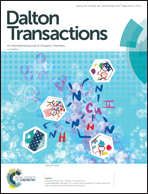Improving the SMM and luminescence properties of lanthanide complexes with LnO9 cores in the presence of ZnII: an emissive Zn2Dy single ion magnet†
Abstract
Mononuclear complexes of stoichiometry [Ln(H3L)(H2O)(NO3)](NO3)2 (Ln = Tb, 1; Dy, 2, Er, 3), which crystallise with different solvates, and the heterotrinuclear compound [Zn2Dy(L)(NO3)3(OH)] (4) can be obtained with the same H3L compartmental ligand. The single X-ray crystal structure of the mononuclear complexes shows a LnO9 core with a muffin-like disposition while the geometry of the DyO9 core in 4 seems to be closer to spherical capped square antiprism. The analysis of the magnetic properties of all the complexes demonstrates that the mononuclear lanthanide compounds do not show slow relaxation of the magnetization, even when the samples are diluted with a diamagnetic matrix and subjected to a dc applied field of 1000 Oe. Nevertheless, the heterotrinuclear dysprosium complex 4·3H2O is a field-induced single ion magnet, with an estimated Ueff barrier of 59 K. The luminescence characterisation of all the metal complexes in methanol solution at 298 K also shows a notable increase in the fluorescence emission of the heterotrinuclear complex with respect to the mononuclear ones, in such a way that 4 can be defined as a fluorescent single ion magnet.



 Please wait while we load your content...
Please wait while we load your content...